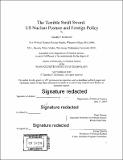| dc.contributor.advisor | Vipin Narang. | en_US |
| dc.contributor.author | McDonnell, Timothy P. | en_US |
| dc.contributor.other | Massachusetts Institute of Technology. Department of Political Science. | en_US |
| dc.coverage.spatial | n-us--- | en_US |
| dc.date.accessioned | 2020-03-24T15:37:27Z | |
| dc.date.available | 2020-03-24T15:37:27Z | |
| dc.date.copyright | 2019 | en_US |
| dc.date.issued | 2019 | en_US |
| dc.identifier.uri | https://hdl.handle.net/1721.1/124274 | |
| dc.description | Thesis: Ph. D., Massachusetts Institute of Technology, Department of Political Science, 2019 | en_US |
| dc.description | Cataloged from PDF version of thesis. | en_US |
| dc.description | Includes bibliographical references. | en_US |
| dc.description.abstract | This dissertation explains how and why US nuclear posture has changed from the late 1940s to the present. It argues that presidents reliably pursue aggressive nuclear postures to advance their ambitious foreign and security policy goals. In the course of advancing this main argument, it makes five additional contributions. First, it overturns the conventional or folk wisdom that Mutual Assured Destruction (or MAD) characterized US Cold War nuclear posture. In fact, the desire to escape MAD-not maintain it-was a major driver of aggressive US posture. Second, it upends the standard political science argument that US nuclear posture became aggressive as a result of military service rivalries or bureaucratic pathologies within the Pentagon. When it comes to nuclear posture, presidents carry far more weight than bureaucrats. Third, it fills an important gap in the existing literature. Barrels of ink have been spilled on US nuclear weapons policy and related topics. | en_US |
| dc.description.abstract | However, surprisingly, this is the first attempt at a full-length history of US nuclear posture. Fourth, it illuminates the character of the United States' post-World War II grand strategy. For over seventy years that grand strategy has encompassed three core objectives: defending the US homeland, especially against nuclear attack; protecting distant allies in Europe and Asia from their stronger nuclear-armed neighbors; and denying the security benefits of nuclear weapons to adversaries and allies alike. The costs and risks that US presidents have consistently accepted to pursue these far-reaching goals challenges America's self-image as a benevolent steward of international order. Fifth, this project explains our nuclear posture history with a view towards facilitating wise decisions in the present. Today the US faces decades of great power competition. We are also undertaking a major nuclear modernization effort. | en_US |
| dc.description.abstract | By showing how thirteen presidents have set goals, made trade-offs, and balanced costs and risks in the past, I intend to facilitate the kind of informed debates on foreign policy and nuclear posture that American democracy deserves and demands. | en_US |
| dc.description.statementofresponsibility | by Timothy P. McDonnell. | en_US |
| dc.format.extent | 449 pages | en_US |
| dc.language.iso | eng | en_US |
| dc.publisher | Massachusetts Institute of Technology | en_US |
| dc.rights | MIT theses are protected by copyright. They may be viewed, downloaded, or printed from this source but further reproduction or distribution in any format is prohibited without written permission. | en_US |
| dc.rights.uri | http://dspace.mit.edu/handle/1721.1/7582 | en_US |
| dc.subject | Political Science. | en_US |
| dc.title | The terrible swift sword : US nuclear posture and foreign policy | en_US |
| dc.title.alternative | US nuclear posture and foreign policy | en_US |
| dc.title.alternative | U.S. nuclear posture and foreign policy | en_US |
| dc.title.alternative | United States nuclear posture and foreign policy | en_US |
| dc.type | Thesis | en_US |
| dc.description.degree | Ph. D. | en_US |
| dc.contributor.department | Massachusetts Institute of Technology. Department of Political Science | en_US |
| dc.identifier.oclc | 1144176529 | en_US |
| dc.description.collection | Ph.D. Massachusetts Institute of Technology, Department of Political Science | en_US |
| dspace.imported | 2020-03-24T15:37:26Z | en_US |
| mit.thesis.degree | Doctoral | en_US |
| mit.thesis.department | PoliSci | en_US |
